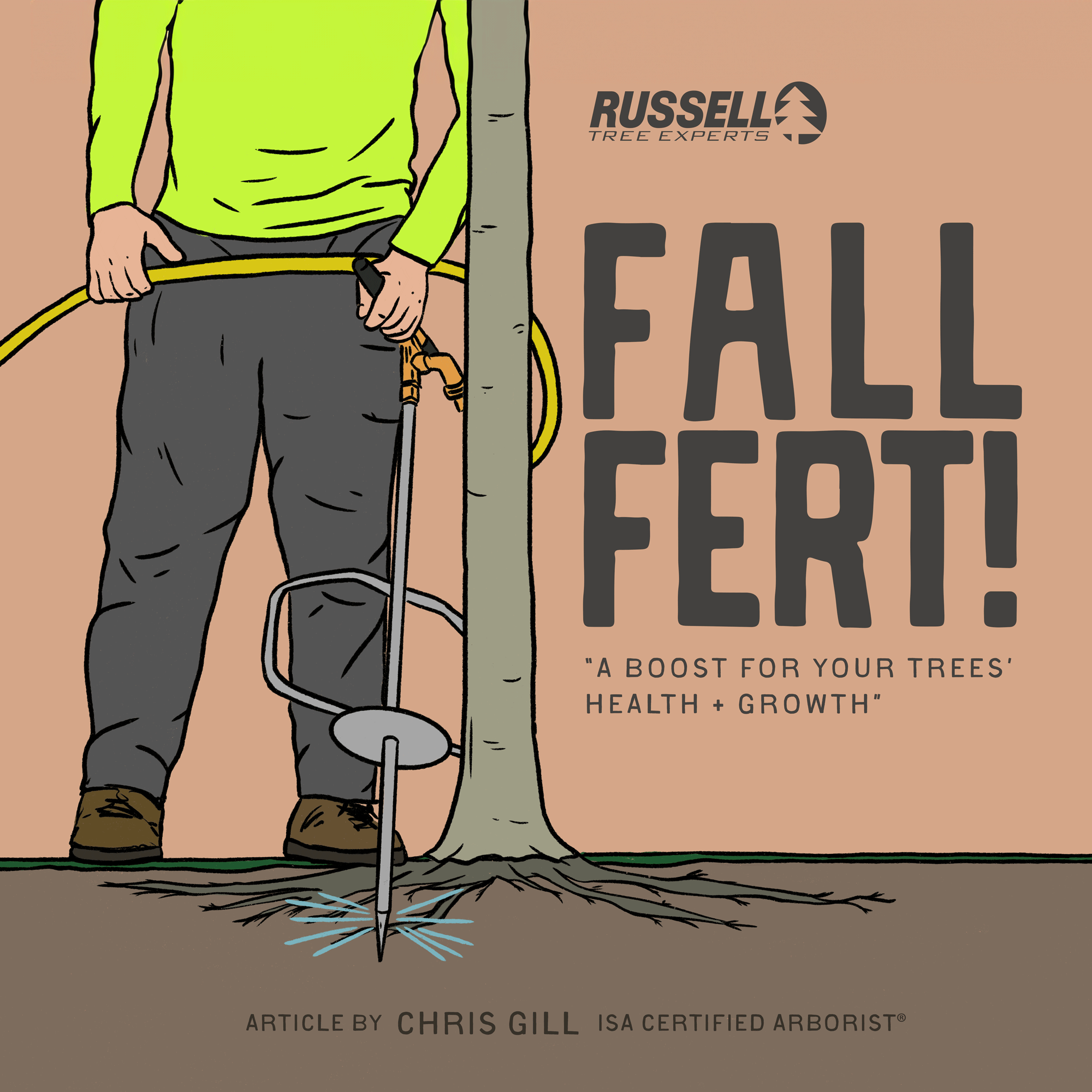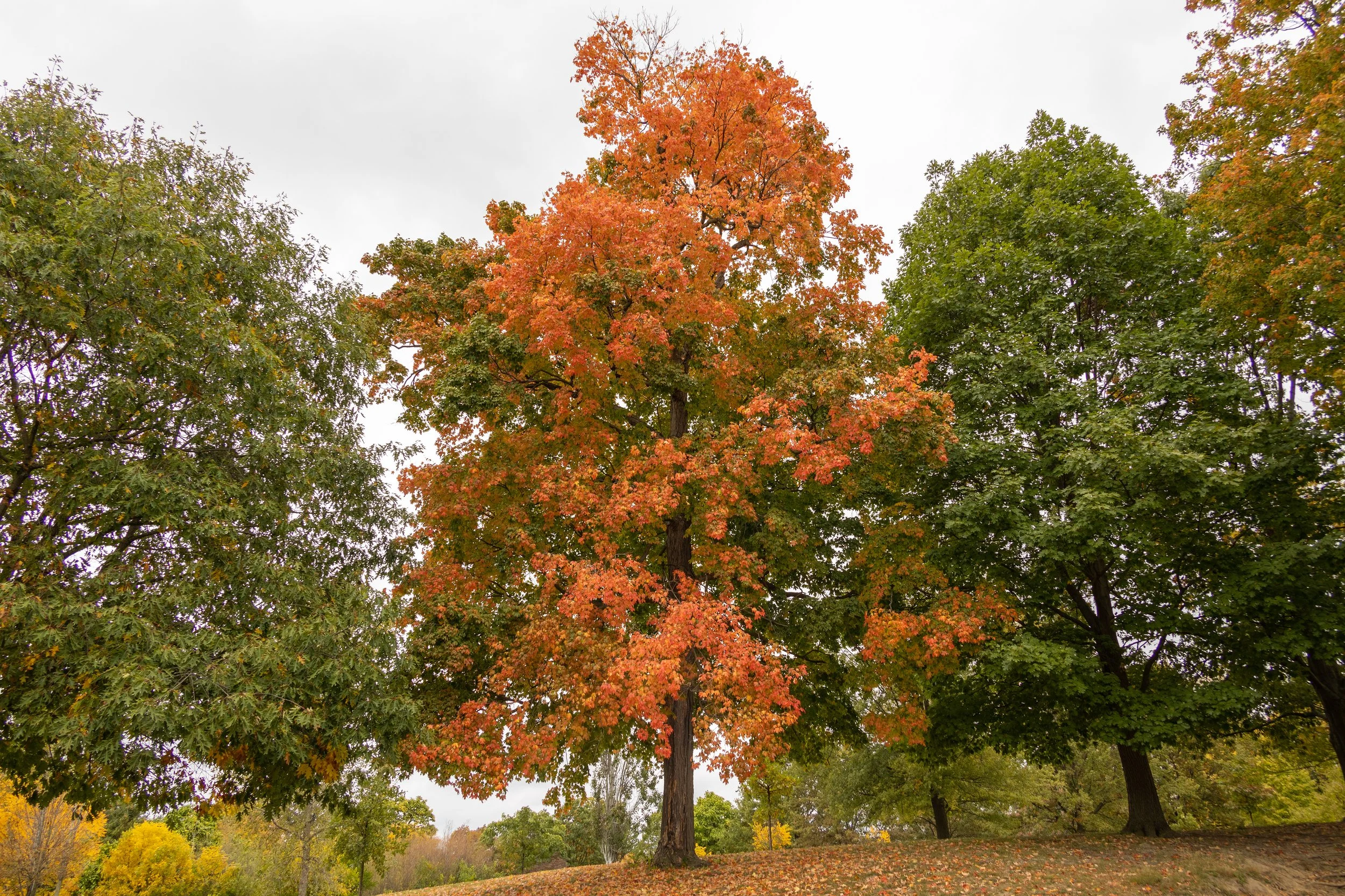By Chris Gill
ISA Certified Arborist® OH-6416A
October 9, 2025
As the leaves turn vibrant shades of orange and red and the air grows crisp, fall signals a time of transition for trees. While many of us associate fertilization with spring, fertilizing trees in the fall offers unique and powerful benefits that can set your trees up for success. By giving your trees a nutrient boost as the growing season winds down, you’re helping them thrive through winter and into the next year. Additionally, combining fall fertilization with spring fertilization can amplify these benefits, helping to ensure your trees remain healthy, strong, and beautiful year-round.
At Russell Tree Experts, we fertilize trees through a technique called deep-root fertilization. We perform deep-root fertilization by using a lance to inject liquid fertilizer under pressure deep into the feeder root system in a soluble form that is easy for the tree to take up. This is superior to a traditional surface application where a granular fertilizer is spread over the root system of a tree but still requires time for the product to break down and work itself into the soil. Deep-root fertilization allows nutrients to pass by the competitive roots of turf, weeds, and other ground covers to maximize uptake for the tree. The process of deep root fertilization also helps to loosen up compacted soil around the tree to promote better root growth while also allowing water and oxygen to more easily reach the roots. Compacted soil is a common problem in urban landscapes and can reduce a tree’s ability to access nutrients.
Why Fall Fertilization Matters
In the fall, trees shift their energy from producing leaves and growing branches to strengthening their root systems and preparing for dormancy. This is a critical time for trees, as they store nutrients to survive the cold months ahead. Fertilizing in the fall provides the essential nutrients trees need to bolster their roots, improve resilience, and prepare for a robust start in spring.
One method of fall fertilization is through the use of an irrigation lance to deliver nutrients below ground, closer to a tree’s roots.
One of the biggest benefits of fall fertilization is root development. During autumn, trees focus on growing their roots, which anchor them and absorb water and nutrients. By applying fertilizer in the fall, you give trees the building blocks they need to expand and strengthen their root systems. Stronger roots mean trees are better equipped to handle drought, storms, and other environmental stresses.
Fall fertilization also helps trees store nutrients for winter. As trees enter dormancy, they rely on stored energy to survive until spring. Fertilizer provides a nutrient reserve that trees can draw upon during this period, to help them emerge from winter in a healthy condition. This nutrient boost supports overall tree health, leading to better resistance against pests, diseases, and harsh winter conditions.
Another advantage of fall fertilization is improved bud and flower formation. The nutrients provided in the fall contribute to the development of next season’s buds, which means healthier blooms and foliage when spring arrives. Trees that are well-nourished in the fall often produce healthier flowers and lusher leaves, enhancing your landscape.
The Power of Combining Fall and Spring Fertilization
While fall fertilization lays a strong foundation for tree health, pairing it with spring fertilization creates a dynamic duo for year-round vitality. Spring is a time of rapid growth, as trees produce new leaves, flowers, and branches. Fertilizing in the spring provides an immediate supply of nutrients to fuel this growth. It supports vigorous shoot development, leading to fuller canopies and stronger branches. Spring fertilization also enhances photosynthesis, helping trees produce the energy they need to grow and thrive.
When you fertilize in both seasons, you’re giving your trees a balanced nutrient plan. Fall fertilization builds the root system and prepares trees for winter, while spring fertilization supports above-ground growth and energy production. Together, they help your trees have the resources they need at every stage of their growth cycle. This combination promotes long-term health, making trees more resilient to environmental challenges and helping them live longer, more productive lives.
In summary, fall fertilization is a simple and effective way to support your trees’ health, strengthening their roots and preparing them for winter. By taking the time, this fall to nourish your trees, you’ll help them thrive for seasons to come. For a free tree work quote by one of our 25+ ISA Certified Arborists®, visit RussellTreeExperts.com/Quote or call us at (614) 895-7000!
ADDITIONAL ARBOR ED™ ARTICLES!
Chris Gill I Regional Manager, Russell Tree Experts
Chris joined Russell Tree Experts in 2015 and has been in the green industry for over 15 years. When not at RTE, he enjoys spending time with wife & son, wakeboarding, and hunting. His favorite trees are the white oak & sugar maple for their beauty and uses beyond the landscape. Chris is an ISA certified arborist, EHAT certified, CPR and first aid certified, holds an ODA commercial pesticide license, and holds a tree risk assessment qualification (TRAQ).











